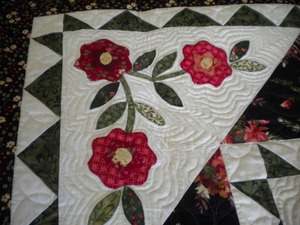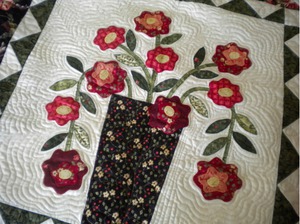While there are many different appliqué techniques available to today’s quilter, rough edge appliqué is one of the easiest to learn making it a popular choice for even beginner quilters. While many patterns and designs are created specifically with this technique in mind, others can easily be adapted for use with this method.


Simple appliqué shapes such as flowers and leaves are good choices for rough edge appliqué.
To rough edge appliqué, use hand or machine stitches to sew around the a piece of fabric’s edges to attach it to your base piece of fabric. If you’re working with only a few pieces of fabric, you can use a straight stitch sewing by hand from 1/16″ to 1/4″ away from the edge of the top fabric. Machine stitching is best when your project contains a lot of pieces that need to be appliquéd. Increase your stitch length just a tad to add more of a hand-stitched look to the project, as tiny stitches could cause the fabric to pucker. As you go along, the edges on the top piece of fabric don’t get turned under, giving the piece a raw-edge finish. Layers upon layers of fabric sewn using raw-edge appliqué can create a beautiful textured embellishment. When washed, quilts and items using this technique have a soft, frayed, time-worn look that is very appealing.
When selecting the best thread to use for your rough edge appliqué decide upon whether you’d prefer for its color to contrast or coordinate with your top fabric. If you’re interested in creating a bolder look, a slightly thicker thread can also be used. If you’re working by hand, consider using embroidery floss or perle cotton to achieve the look you desire.
Rough edge appliqué can be used with or without a fusible product to hold pieces in place while machine or hand stitching. Heat ?n Bond Lite is a reliable choice if a fusible is used. If a fusible product isn’t used, a pin placed in the center of the appliqué shape works. When using a fusible product, choose a product that won’t be too stiff. One way to ensure that your fused fabric isn’t overly stiff is to use only a partial fusible backing. For example, if you are fusing a circle cut out the center of the fusible backing so that the circle is only fused at the edges. This will help the quilt to maintain its soft and supple form while using a fusible product for stability.

Share tips, start a discussion or ask one of our experts or other students a question.
No Responses to “Rough Edge Appliqué: An Easy Embellishment Technique”